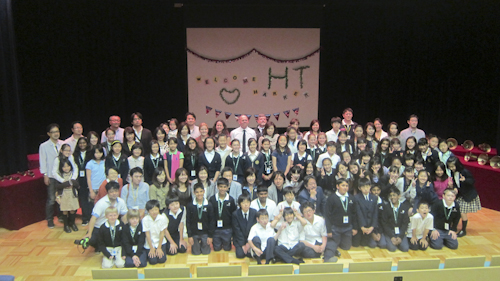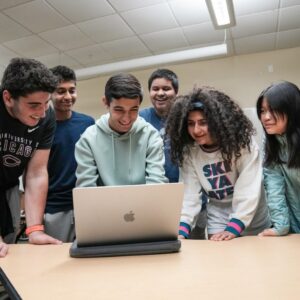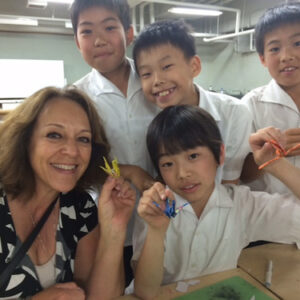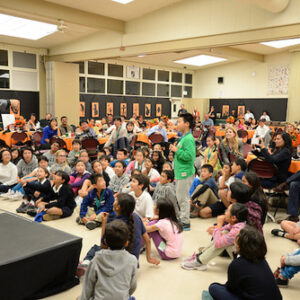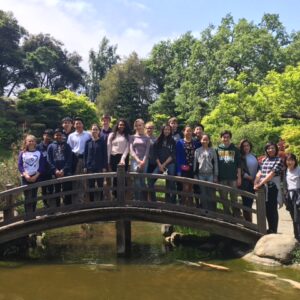Grade 6 students boarded a Tokyo-bound plane on May 10 for the annual trip to Japan. The 18 students, along with chaperones Jennifer Walrod, global education director, and Dan Hudkins, director of instructional technology, arrived in Tokyo after an 11-hour flight and were greeted by a tour guide and an English teacher from Tamagawa Gakuen. At a rest stop on their way to their hotel for their first night’s stay, the students sampled Japanese snacks, ice cream and fried chicken.
Their first stop on the weeklong trek was Hakone National Park, where they visited the Hakone sekisho (“checkpoint”), an important inspection area for travelers during Japan’s Edo period, and walked along Lake Ashi. A boat ferried the group to the other side of the lake, where a beautiful wooded area awaited them. “We stopped at a small Shinto shrine where the kids wished for good luck before heading back,” Walrod said in one of several emails to the parents she sent during the trip. “The kids then had the opportunity to create a wooden mosaic cup placemat, taking their time gluing each individual piece together.”
Afterward, they rode a gondola to the top of a nearby mountain, where they took photos of the breathtaking scenery.
Saturday was special for the Harker students, as they reunited with their buddies from Tamagawa. En route to the school’s campus, the students practiced their Japanese speeches and asked questions about their homestays. “As we drove across the Tamagawa campus we could see all our buddies, families and teachers outside the middle school awaiting our arrival. The kids were so excited!” Walrod said.
At their welcome ceremony, the Harker students were treated to a performance by Tamgawa’s handbell ensemble, accompanied by two singers. “Our students did a great job with their Japanese speeches!” exclaimed Walrod. Two Harker students, Sameep Mangat and Ania Kranz, sang a duet to their Tamagawa friends. During the rest of their time at Tamagawa the students enjoyed a scavenger hunt and a variety of Japanese treats. Afterward, the Harker students went to enjoy the rest of the day with their homestay families.
During their first full school day at Tamagawa, the Harker kids accompanied their Tamagawa buddies to a number of classes, including math, Japanese, science and P.E. Later, they met with Yoshiaki Obara, president of Tamagawa, to share with him their experiences so far during the trip. “He told the kids that this trip was good for them as it made them realize that not everyone spoke English,” Walrod wrote. “He then encouraged the kids to be sure to speak slowly when talking with their buddies and other Japanese kids.”
The students later gave presentations on American culture during an English class, covering topics such as the Fourth of July, music and food.
May 15 started with the Harker students being introduced to all of Tamagawa’s middle school students. “It was a wonderful experience for our kids listen to their peers sing a few songs, including their school song, in four-part harmony,” Walrod wrote. From there, the students received a tour of some of the Tamagawa facilities, including the planetarium and the Future Sci Tech Lab, where they saw a presentation by a representative from their Plant Factory Research Center and Space Farming Lab, during which they learned of Tamagawa’s involvement with the research of crop production in space.
Later, the students enjoyed lunch with their Tamagawa friends and spent the afternoon in a calligraphy class.
The following day was the Harker students’ last day at Tamagawa. In the morning, they were introduced to Tamagawa’s lower school students and visited several classes, where they played games, folded origami, enjoyed activities with hula hoops and more. After a potluck lunch, the students enjoyed a farewell party. “Tamagawa kids sang, played the piano, danced and gave speeches, all performed and organized by the ‘Harker Welcome Committee,’ a student run group who had organized much of our visit to the school,” Walrod said. Mangat and Kranz again sang to their Tamagawa friends, and Rajiv Movva gave a moving speech. The Harker visitors each then received a gift bag from their Tamagawa buddies.
“As the bus drove away, we passed tons of kids and families lining the sidewalk waving goodbye,” Walrod remembered. “Between the sounds of the kids laughing and sharing their homestay stories with one another, we could hear several kids still sniffling and crying, sad to see such a wonderful experience come to an end.”
Thursday began with a two-hour shinkansen (“bullet train”) ride to Kyoto, where they met with Ms. Sawa, who would act as their guide for the rest of the group’s stay in Japan. They first visited Kiyomizu Temple, a Buddhist temple constructed without the use of any nails. The temple’s veranda offered a wonderful view for taking photos, and the students also paid to receive their fortunes, “and for those of us who got not-so-good fortunes, we were sure to tie the paper fortunes onto a railing provided so we could keep the adverse fortune at the temple,” Walrod said.
At the Jishu shrine, the group found two stones placed approximately 20 feet away from one another. Local legend told that those who could find their way from one stone to the next with their eyes closed would find true love. Those who needed assistance would need a “go between” to help them in finding their mates.
Students also had the chance to write their troubles on a paper doll, which was then placed into a bowl of water to be dissolved, along with their worries.
After exploring more of the temple, the next stop was the famed Kinkakuji, also known as the Temple of the Golden Pavilion. The brilliant golden building, situated in a pond, is surrounded by gorgeous trees, with the scenery reflecting off the surface of the water. The students were instructed not to talk. “We walked around the pond and through the trees, stopping to take photos of the natural beauty,” said Walrod.
Later the students tried their hand at landing a coin in a bowl placed in a tree. If successful, the thrower was supposedly guaranteed good luck. The students also purchased candles that were said to bring good fortune and enjoyed snacks from vending machines.
Finally, the students visited a yuzen cloth dying center, where they made their own scarves with stencils and paint.
On their last full day in Japan, the group boarded the shinkansen to Hiroshima. There, they stopped briefly at Hiroshima castle for a quick photo op, then continued on to Miyajima Island. The group enjoyed lunch at a restaurant that specialized in okonomiyaki, a pancake made with egg, pork, soba noodles and other ingredients. “The kids seemed to really enjoy this meal as there were lots of empty plates at the end of lunch,” Walrod said.
With lunch finished, everyone headed to Itsukushima Shrine and its famous torii (“gate”). The gate was covered with scaffolding due to a storm that blew off the top of the structure, but students nevertheless took several photos of the historic site.
The next stop on this very busy day was Peace Memorial Park, where they visited the Atomic Bomb Dome, which marks the spot where the first atomic bomb landed in Japan. The ruins at the site are dedicated to those who died at the site. Later, they delivered 1,000 paper cranes they had folded earlier this year to the Children’s Memorial, referencing the famous true story told in the book “Sadako and the 1,000 Paper Cranes.” The cranes were hung in an enclosure along with thousands of other similar cranes delivered by kids from all over the world.
Continuing through the park, the group stopped briefly at the Flame of Peace, which has burned since first being lit in 1964. “This flame continues to burn as a symbol of the Japanese anti-nuclear resolve to burn the flame until all nuclear weapons are gone from this earth,” said Walrod.
Finally, at the Peace Memorial Museum, the students learned about the events surrounded the bombing of Hiroshima and the effects thereafter. The museum contained artifacts owned by survivors of the bombing and some of the paper cranes folded by Sadako Sasaki, the titular figure of “Sadako and the 1,000 Paper Cranes.”
The trip back to the hotel gave the students time for reflection on the meaning of peace and the fun-filled, memorable journey they had embarked on over the last week.
On May 19, the last day of sightseeing, the group went to the scenic Arashiyama, a popular tourist spot located just outside of Kyoto. While hiking up Arashiyama Mountain, the students noticed some of the area’s wildlife. “The kids were excited to spot the first monkeys running up the side of the mountain and in the trees,” Walrod said. “At the top of the mountain, there were dozens of monkeys wandering around.” The kids also got to feed the monkeys in a special “people cage.”
The final stop of the day was at Kyoto’s Nijo Castle, home of the Tokugawa Shogunate. The visitors removed their shoes before entering the castle, which had special floors installed during the Tokuagawa period that made noise when walked upon so that assassins could not walk about the castle undetected. “Only highly trained ninjas can walk on these floors silently,” said Walrod. After taking photos and viewing scenes and paintings of life as a shogun, everyone headed back to the airport for the long flight home.
